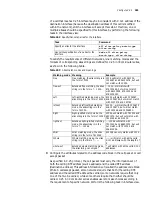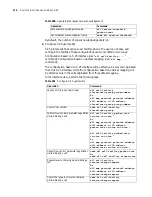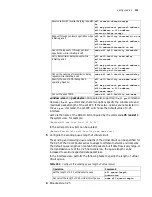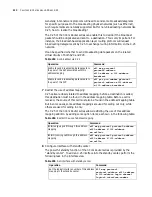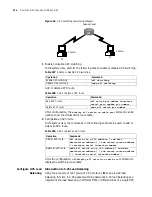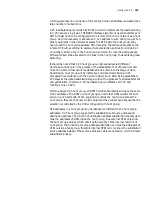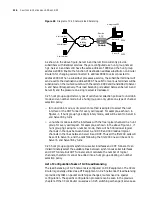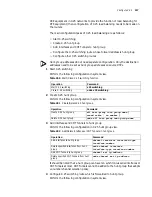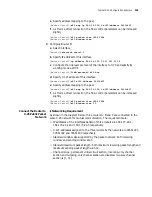
Configure X.25 over Other Protocols
219
protocol provides reliable data transmission link. Because TCP has the mechanism
of error redirection and window flow controlling to guarantee the reliability of
links, it can be used by X.25. XOT builds a TCP tunnel connection between the
two X.25 networks, and the X.25 packets are supported by TCP as data of
application layer, i.e., TCP serves as the “link layer” of X.25. You can regard the
middle RouterB, RouterC and IP net as a big “X.25 switch”, and data is directly
switched from RouterA to RouterD through this “switch”.
The XOT features implemented in the 3Com Router accords with RFC1613
recommendation, and it possess the following features:
■
Supporting SVC application. The two routers can dynamically set up a SVC by
sending call packet, and the VC will automatically be cleared when no data is
transmitted.
■
Supporting PVC application. After the two routers configure a PVC, they
directly enter the data transmission status without the process of call
establishing. If no data is transmitted, this VC will not be cleared automatically.
■
Supporting the Keepalive attribute of TCP. If Keepalive is not configured, TCP
connection will not be cleared after a long period of time when the line is
disconnected. If Keepalive is configured, TCP check the usability of the links in
time, and it will automatically clear the TCP connection if it does not receive
the answer of the opposite side for certain times.
Implementing theory of XOT (taking SVC as an example):
As shown in the former figure, when it has data to transmit, RouterA first send a
request packet to set up a VC. After RouterB receive the call packet and judges
that it is XOT application, it first set up a TCP connection with RouterC, and then
stick the XOT packet header to X.25 call packet which is encapsulated in TCP
header to send to RouterC. RouterC takes off the TCP and XOT packet headers
and send the call request packet to RouterD through X.25 local switch. After
RouterD receives the call request packet, it answers the call to confirm until the
link is completely set up and enters the data transmission status. To RouterA and
RouterD, the whole process of setting up and applying TCP connection is
transparent, and they do not and cannot care whether the data is forwarded
through IP net or X.25 net.
Configure XOT
XOT configuration includes:
■
Start X.25 switching
■
Configure IP side interface
■
Configure local switching (SVC)
■
Configure XOT route
■
Configure Keepalive and xot-source attributes
■
Start X.25 switching
Because the XOT is the extension of X.25 switch, first you have to start X.25
switch.
Perform the following tasks in system view.
Summary of Contents for 3036
Page 1: ...http www 3com com 3Com Router Configuration Guide Published March 2004 Part No 10014299 ...
Page 4: ...VPN 615 RELIABILITY 665 QOS 681 DIAL UP 721 ...
Page 6: ...2 ABOUT THIS GUIDE ...
Page 7: ...I GETTING STARTED Chapter 1 3Com Router Introduction Chapter 2 3Com Router User Interface ...
Page 8: ...4 ...
Page 16: ...12 CHAPTER 1 3COM ROUTER INTRODUCTION ...
Page 34: ...30 ...
Page 60: ...56 CHAPTER 3 SYSTEM MANAGEMENT ...
Page 98: ...94 CHAPTER 6 DISPLAY AND DEBUGGING TOOLS ...
Page 110: ...106 ...
Page 114: ...110 CHAPTER 8 INTERFACE CONFIGURATION OVERVIEW ...
Page 158: ...154 CHAPTER 10 CONFIGURING WAN INTERFACE ...
Page 168: ...164 ...
Page 188: ...184 CHAPTER 13 CONFIGURING PPPOE CLIENT ...
Page 192: ...188 CHAPTER 14 CONFIGURING SLIP Router ip route static 0 0 0 0 0 0 0 0 10 110 0 1 ...
Page 248: ...244 CHAPTER 16 CONFIGURING LAPB AND X 25 ...
Page 320: ...316 ...
Page 330: ...326 CHAPTER 20 CONFIGURING IP ADDRESS ...
Page 362: ...358 CHAPTER 21 CONFIGURING IP APPLICATION ...
Page 374: ...370 CHAPTER 23 CONFIGURING IP COUNT ...
Page 406: ...402 CHAPTER 25 CONFIGURING DLSW ...
Page 408: ...404 ...
Page 452: ...448 CHAPTER 29 CONFIGURING OSPF ...
Page 482: ...478 CHAPTER 30 CONFIGURING BGP ...
Page 494: ...490 CHAPTER 31 CONFIGURING IP ROUTING POLICY ...
Page 502: ...498 ...
Page 508: ...504 CHAPTER 33 IP MULTICAST ...
Page 514: ...510 CHAPTER 34 CONFIGURING IGMP ...
Page 526: ...522 CHAPTER 36 CONFIGURING PIM SM ...
Page 528: ...524 ...
Page 532: ...528 CHAPTER 37 CONFIGURING TERMINAL ACCESS SECURITY ...
Page 550: ...546 CHAPTER 38 CONFIGURING AAA AND RADIUS PROTOCOL ...
Page 590: ...586 CHAPTER 40 CONFIGURING IPSEC ...
Page 599: ...IX VPN Chapter 42 Configuring VPN Chapter 43 Configuring L2TP Chapter 44 Configuring GRE ...
Page 600: ...596 ...
Page 638: ...634 CHAPTER 43 CONFIGURING L2TP ...
Page 649: ...X RELIABILITY Chapter 45 Configuring a Standby Center Chapter 46 Configuring VRRP ...
Page 650: ...646 ...
Page 666: ...662 ...
Page 670: ...666 CHAPTER 47 QOS OVERVIEW ...
Page 700: ...696 CHAPTER 49 CONGESTION MANAGEMENT ...
Page 706: ...702 CHAPTER 50 CONGESTION AVOIDANCE ...
Page 707: ...XII DIAL UP Chapter 51 Configuring DCC Chapter 52 Configuring Modem ...
Page 708: ...704 ...
Page 762: ...758 CHAPTER 52 CONFIGURING MODEM ...

